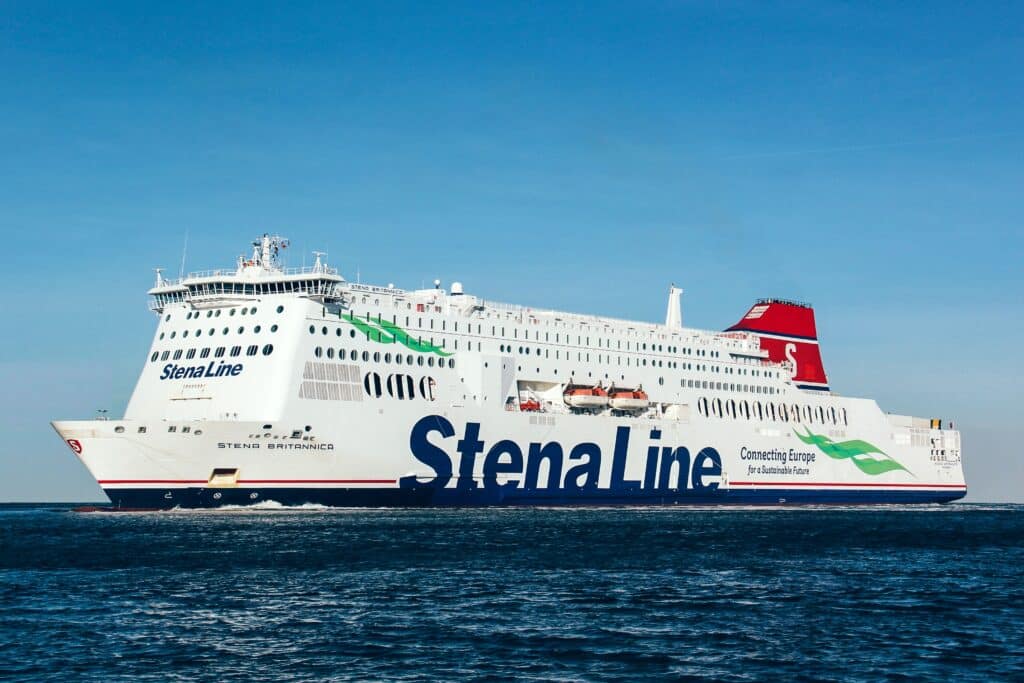If you’ve ever wondered whether you can bring your dog on a ferry, we’ve got good news. Our team looked into Stena Line’s Irish Sea crossings, and we’re genuinely impressed with the dog-friendly choices available. Whether you’re heading from Belfast to Cairnryan or taking the Dublin–Holyhead route, there are now proper options to keep your dog comfortable during the trip.
From onboard pet lounges and kennels to in-car travel and cabins (on certain routes), Stena’s made a real effort. Below we’ve broken down what you need to know for each route, so you can travel confidently and keep your dog happy along the way.
Let’s set sail.
Belfast – Cairnryan (Stena Superfast Ferries)
The Belfast to Cairnryan crossing (connecting Northern Ireland with Scotland) is a short ferry trip of about 2 hours 15 minutes, with up to six sailings a day. Stena Line’s modern Stena Superfast VII and Superfast VIII vessels operate this route. While there are no pet-friendly cabins on the Belfast–Cairnryan ships, Stena Line has introduced a fantastic alternative: a dedicated Pet Lounge on board.
Pet Lounge
In May 2023, Stena Line opened an exclusive Pet Lounge on the Superfast ferries for this route. You’ll find the lounge on Deck 7 can be pre-booked for you and your pet for €24 per pet (maximum 2 pets per booking). It seats up to 30 passengers and has room for 10 pet carrier cases, so you can relax with your dog during the journey. The lounge offers complimentary tea and coffee for pet owners, with water bowls provided for pets. Note that your dog (or other pet) must remain secured in a ventilated pet carrier crate at all times while in the Pet Lounge. This rule is for everyone’s comfort and safety, since the lounge may host various types of pets (not just dogs).
Before entering the lounge, you’ll need to place your dog in its carrier, but you may walk your dog on a lead from the car deck or terminal to the Pet Lounge. Once on board, there’s even a designated outdoor deck area nearby where Pet Lounge users can take their dogs out for a brief bit of fresh air and a toilet break during the voyage (leashes required). The Pet Lounge has secure keypad access; you’ll receive the code at check-in so only pet travellers can enter.
Remember to pre-book the Pet Lounge in advance, as spaces are limited and demand is high, if it’s full, your pet will have to stay in your vehicle or in a kennel for the crossing.
It’s important to note that the Pet Lounge on the Belfast to Cairnryan route is currently only suitable for small to medium-sized dogs due to carrier size restrictions. Larger breeds are not accommodated in the lounge and must remain in the car or use kennel facilities instead.
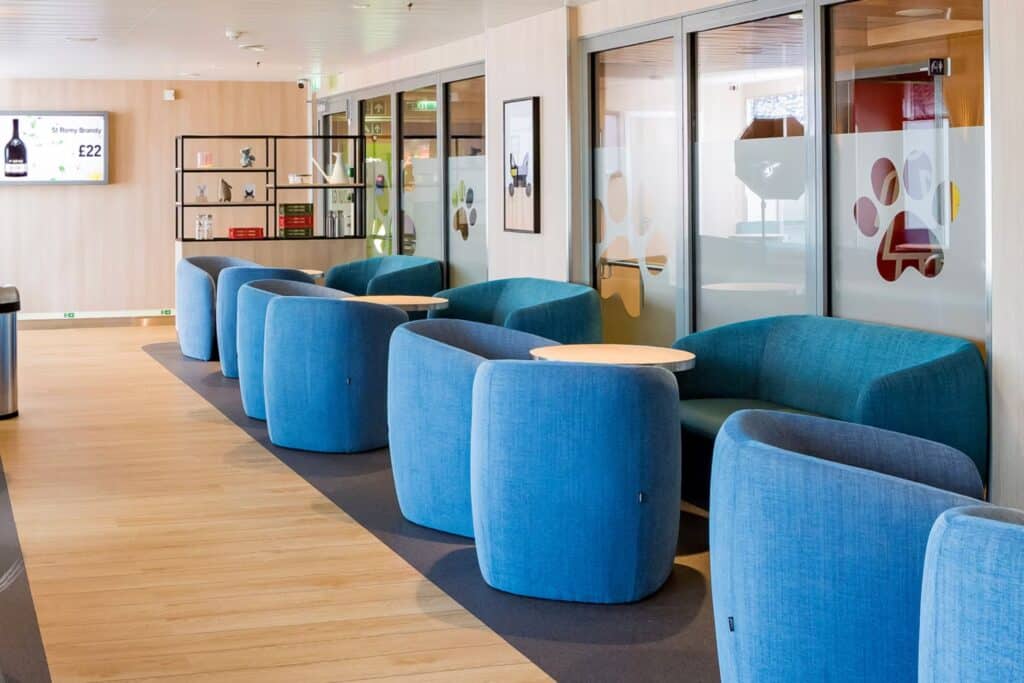
Ref: Superfast Pet Lounge
Kennels and In-Car Travel
If you prefer not to use the Pet Lounge (or it’s fully booked), on-board kennels are available on the Belfast–Cairnryan route and these are free of charge, but they must be reserved in advance. The kennels on this route are located on the car deck, and while secure, they are not in passenger areas (meaning you generally cannot visit your pet during the short crossing). Many pet owners on this 2¼ hour route simply choose the “in-car” option, leaving their dog in their vehicle on the car deck for the duration of the sailing. This is allowed on the Cairnryan route and also free of charge (no pet fee). If your dog is comfortable in the car, you might decide this is the least stressful option, given the crossing is relatively short. Make sure to park in the shade on the car deck if possible, leave windows slightly ajar for ventilation, and provide a familiar blanket and water.
Stena Line crew will advise if and when you are permitted to check on your pet on such a short sailing, it may not be necessary or possible to go to the car deck, so give your dog a good walk before boarding. Foot passengers with dogs on this route must either book the Pet Lounge or a kennel, since pets are not allowed in the ordinary passenger areas. If you arrive on foot with a dog and haven’t pre-arranged a pet space, you will not be allowed to travel. Always include your pet in your booking and show up early at the terminal.
Check-In and Boarding (Belfast–Cairnryan)
When travelling with a pet on this route, check in as normal, there is no special check-in process if you have a pet booked. If you’re in a vehicle, just inform the check-in staff that you have a pet (your booking will indicate this) and they’ll give you any instructions needed (for example, they may provide the Pet Lounge access code if applicable, or direct you to park near the kennel area on the car deck). Foot passengers with pets will be directed by staff on how to board, usually you can walk on with your leashed dog via the vehicle deck or a special boarding route.
At Belfast and Cairnryan ports, expect to scan your pet’s microchip as part of the pet travel document checks if you are coming from Great Britain into Northern Ireland (more on documentation below). Once on board, if you’ve booked the Pet Lounge, head there with your dog in its carrier; if using a kennel, a crew member will show you where to secure your dog. Keep your pet on a non-retractable lead no longer than 4 feet whenever you are moving through public areas (pets aren’t allowed in regular passenger lounges, so you’ll go straight to the Pet Lounge or kennel). Assistance dogs, however, are an exception, they are allowed to accompany their owners in any passenger area on all Stena Line ships, including cafes and lounges, and do not need to be in a carrier or Pet Lounge (they also travel free).
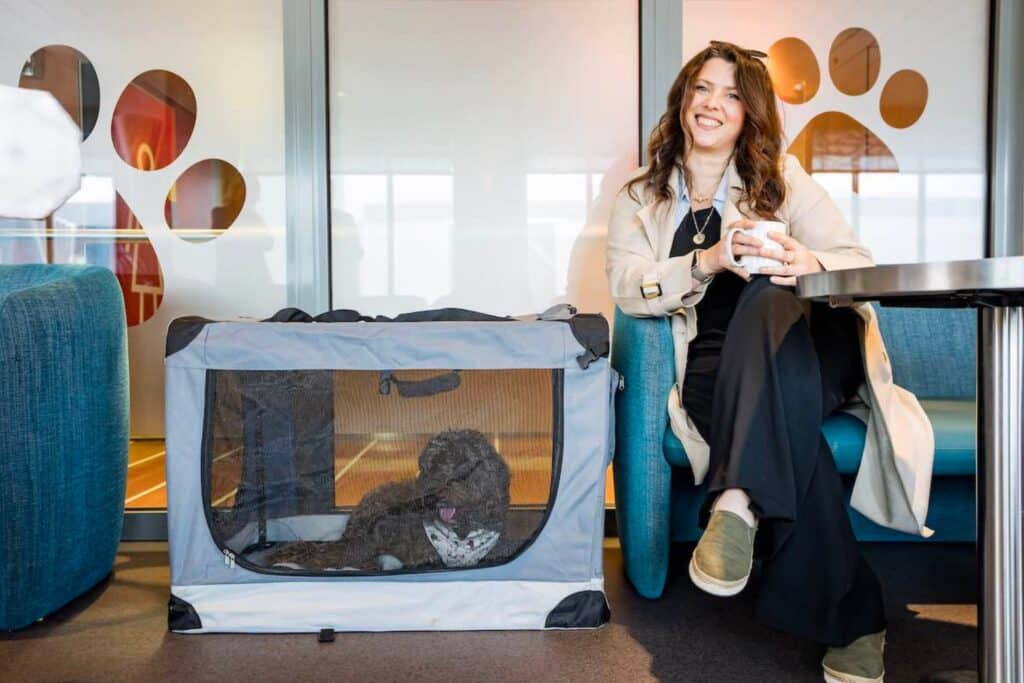
Ref: A pet in a secure case in the Pet Lounge.
Route-Specific Pet Travel Rules (Belfast–Cairnryan)
If you are travelling from Cairnryan (Scotland) to Belfast (Northern Ireland) with a pet, be aware of post-Brexit requirements. From 1 January 2021, Northern Ireland follows EU pet travel rules. This means you’ll need a “Northern Ireland Pet Travel Document” (Pet Travel Document) to bring your dog (or cat/ferret) from Great Britain into Northern Ireland. The Pet Travel Document is a lifetime document (free to apply for) that replaces the old pet passport system for NI; your pet must be microchipped and listed on the document.
As of June 2025, ports have begun scanning microchips and checking these documents for pets entering NI, so make sure you obtain the Pet Travel Document well in advance of your trip. The good news is that with the NI Pet Travel Document, rabies vaccinations and tapeworm treatments are not required for entry into NI (unlike EU travel) as long as your pet is microchipped and has the document. If you’re travelling in the opposite direction (Belfast to Cairnryan), there are currently no routine checks or documents required when bringing your pet from Northern Ireland into Great Britain. (Do ensure your pet is microchipped and you have proof of rabies vaccination just in case, but officially GB does not require any certificate or passport for pets coming from NI.) Still, it’s wise to carry vaccination records or an EU pet passport if you have one, especially if your trip will continue beyond the UK.
Belfast – Liverpool (Stena Edda & Embla)
The ferry from Belfast to Liverpool (Birkenhead) is a longer overnight crossing of roughly 8 hours, typically with two sailings per day (day and night). Stena Line’s new E-Flexer vessels, Stena Edda and Stena Embla, serve this route, offering upgraded pet-friendly facilities. This route connects Northern Ireland with mainland Britain (England), so similar documentation rules apply as with Cairnryan (NI ⇆ GB travel – see below).
Pet-Friendly Cabins
On the Belfast–Liverpool ships, you have the option to book a pet-friendly cabin, allowing you to keep your dog with you in your private cabin throughout the journey. This is an ideal choice, especially given the long overnight trip. Stena Edda and Embla each have a limited number of pet cabins (usually 2 or 4 per sailing, so they sell out fast, plan to book well in advance!). A pet-friendly cabin is just like a regular cabin (en suite shower, toilet, beds, TV) but with vinyl flooring and designated for passengers with pets. Each pet cabin can house up to 2 pets per cabin (max 2 pets per booking).
If you happen to be traveling with more than 2 dogs, any additional pets would need to go into kennels or remain in a vehicle (if allowed) because only two are permitted in the cabin with you. The pet cabins come equipped with some pet amenities: Stena provides water bowls/bottles and disposable pet pee pads in the cabin. However, you should bring your dog’s own bed or blanket and food bowls for comfort, the ferry does not provide pet beds or feeding bowls for hygiene reasons, so it’s best to bring your own familiar items. Bringing your pet’s bedding and favourite toys will help them settle, and don’t forget poop bags to clean up after any accidents.
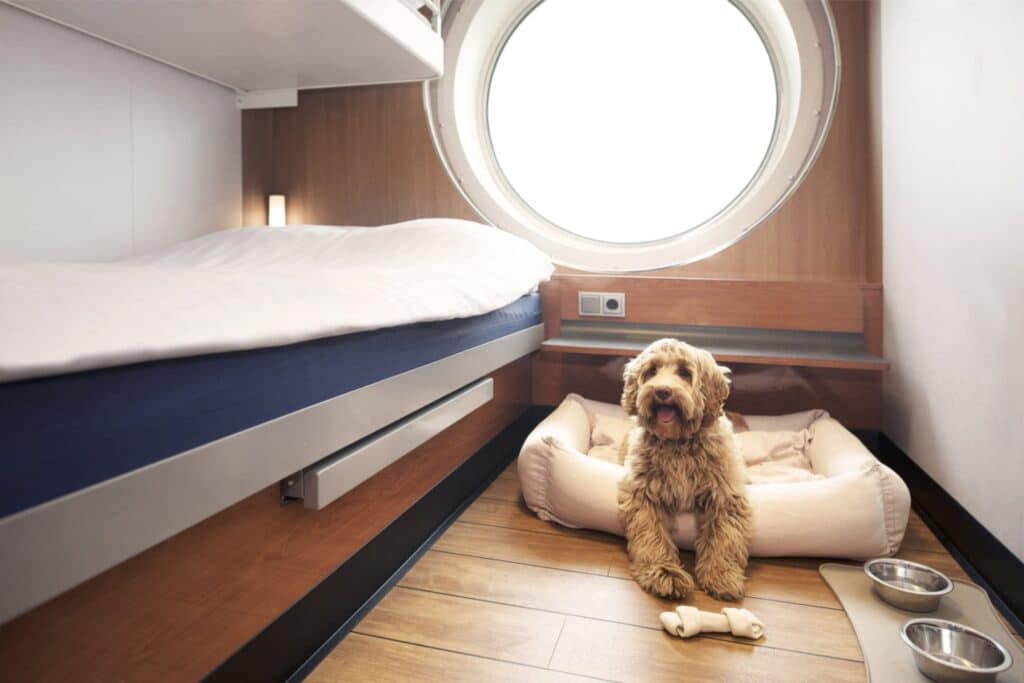
Ref: Pet Friendly Cabins Stenaline
One huge advantage of a pet cabin on the Liverpool route is that you can check on and be with your pet at any time…it’s your cabin. You can even take your dog out for walks on deck during the crossing. Stena Edda and Stena Embla have a designated outdoor exercise area on deck for pets traveling in cabins. This means during the voyage you can bring your dog (on a fixed short lead) out to get fresh air and do their business on an open deck section equipped for pet relief. It’s a great way to break up the long trip, just remember to clean up after your dog and dispose of waste in the bins provided.
Pets must remain on a non-retractable lead at all times on deck, and if your dog has aggressive tendencies you should use a muzzle as a precaution (most dogs don’t need muzzles unless they’ve shown aggression). Generally, dogs do not need to wear a muzzle if they are well-behaved and under control. While in the cabin, your dog can be loose and make themselves at home. You are advised not to leave your dog alone for long periods in the cabin, if you go for a meal or to the shop, try to keep it brief, as some pets may get anxious or cause damage if left alone in a strange environment. If your dog tends to bark or can’t settle without you, plan to stay with them or perhaps have one person fetch food while another stays with the pet. Stena notes that any damage caused by pets (or any injuries) are the owner’s responsibility, so keeping your pet calm and comfortable is in everyone’s interest.
On routes with pet-friendly cabins (such as Liverpool–Belfast, Holyhead–Dublin, and Fishguard–Rosslare), if your dog is to be transported in a carrier to the cabin, the carrier must not exceed the same maximum dimensions: 91 cm x 62 cm x 56 cm. If your dog is too large for the carrier, you have the option to book a kennel (available on several routes), or your dog can remain in your vehicle for the crossing.
Onboard Kennels (Dog Lodges)
If pet-friendly cabins are sold out or you prefer not to book one, the Belfast–Liverpool ships also offer onboard kennels (sometimes referred to as “pet lodges”). These are essentially secure cages or runs in a designated pet area on the ferry. You must pre-book a kennel if you plan to use one, there are a limited number available. Unlike some shorter routes, there is a fee for using the kennels on the Liverpool route. The kennels on Stena Edda/Embla are located in a part of the ship you can access during the voyage.
In fact, one perk on this route is that you are allowed to visit your dog in the kennel throughout the trip and even take them out for walks on deck periodically. Stena Line understands it’s a long crossing, so owners are permitted to check in on their pets. The kennel area is typically accessed with a key or code (crew will inform you), ensuring only owners of kenneled pets can enter. Many travelers report that the kennels are in a secure, ventilated room and that blankets are provided, but you should bring your dog’s bedding or something that smells of home to line the kennel. Also carry a water bowl, Stena’s crew can help ensure water is available.
If you have a foot passenger ticket with a dog on this route, a kennel or pet cabin booking is absolutely required, you cannot travel as a foot passenger with a dog unless you’ve arranged one of these on-board pet accommodations in advance. When you board in Liverpool or Belfast without a vehicle, you’ll be escorted to the kennel area to settle your dog in for the trip, and you can then go to your own seat or cabin (or hang out near the kennel area if you prefer).
Do note that pets are not allowed in any public lounges or cabins except the designated pet cabins on this route (standard cabins and passenger areas are strictly pet-free). Only certified assistance dogs are allowed in passenger areas like bars or restaurants.
In-Car Option
Uniquely, Stena Line does allow pets to remain in the car on the Belfast–Liverpool route as well, though this is generally not the most popular option given the length of the crossing. If your dog is extremely at ease in your vehicle, you can choose to leave them in the car when you drive aboard. However, keep in mind you will not have access to the vehicle during the voyage. The car decks are closed to passengers while at sea, so if your pet is in the car, they’ll be alone for 8 hours with no opportunity for toilet breaks or attention. For many dogs this can be stressful, especially overnight and with the noise/vibrations of a ship. Stena Line does list the in-car pet option for this route, but use your judgment, if you do leave your dog in the car, make sure they have ample ventilation, water, and perhaps training pads in one corner. It’s generally recommended to opt for a cabin or kennel so you can monitor your pet’s well-being on such a long trip. Some travelers with multiple or large dogs who couldn’t get a cabin, do use the car option, but they usually treat it as a last resort. If you do it, try to tire your dog out before boarding and make a comfortable space in your vehicle for them to settle.
Check-In and Boarding (Belfast–Liverpool)
The check-in process is similar to other routes. If driving, arrive early at the port and let the check-in agent know you have pets (again, they’ll see it in the booking and likely give you a “Pet on Board” hanger or sticker for your car). You might be loaded onto the ferry in a specific lane or deck that’s convenient for accessing the kennels or elevators. Once parked on board, do not let your dog out until instructed, usually you’ll wait until other vehicles are parked and a crew member escorts pet owners either to the kennels or pet cabins.
Put on your dog’s lead (and muzzle if required) before exiting the car, and take your pet straight to the kennel area or your cabin as directed. Foot passengers with pets will typically be checked in by staff at the terminal and then bussed or walked on board, whereupon crew will lead you to the pet cabin or kennel. Remember to carry your pet’s documents (for travel between NI and GB), if you’re coming from Britain into Belfast, you should have the NI Pet Travel Document and your dog’s microchip will be scanned when departing Liverpool. If you’re leaving Belfast for Liverpool, no paperwork is needed for GB authorities, but it’s wise to carry vaccination records and any pet passport you have.
During the voyage, if your dog is in a kennel, take advantage of allowed visitation times. Typically, you can go to the kennel area whenever you like (it might be locked, but ask Guest Services for access). For safety, a crew member might accompany you when walking your dog on deck to ensure you stay in the pet-designated areas. At the end of the trip, you’ll return to your vehicle or meet at a designated point to disembark with your pet, port staff will guide you through any arrival checks (for example, in Belfast you may need to stop at the pet document inspection point if coming from GB).
Route-Specific Pet Travel Rules (Belfast–Liverpool)
The same NI Pet Travel Document requirement applies if you are travelling from Liverpool (England) to Belfast with your pet. Make sure you’ve obtained the NI pet document for your dog, and that your dog is microchipped. As of 4 June 2025, Stena Line (and other carriers) will ask you to scan your pet’s microchip at the port of departure (Liverpool) to verify it matches the Pet Travel Document. This is usually done at a self-service scanner or by a staff member. If there’s any issue (chip can’t be read, etc.), you might be directed to speak with a pet travel official upon arrival in Belfast.
If you’re going the other way from Belfast to Liverpool, you do not need any special certificate or pet passport for entry into Great Britain, there are no routine pet checks entering England from NI. (Do ensure your dog is microchipped, as that’s legally required for dogs in the UK anyway.) One thing to keep in mind: Northern Ireland residents don’t need a Pet Travel Document for their own pets to go to GB and back, but if you’re a GB resident visiting NI and returning home, technically you should have either an EU pet passport or get an Animal Health Certificate from a vet for the return trip if you plan onward travel into the EU later. However, if you’re just going back to GB, usually there’s no documentation required at the port. In all cases, ensure your dog’s rabies vaccination is up to date if there’s any chance you’ll be inspected or if you might hop from NI down to the Republic of Ireland later on. It’s better to be safe with paperwork in order.
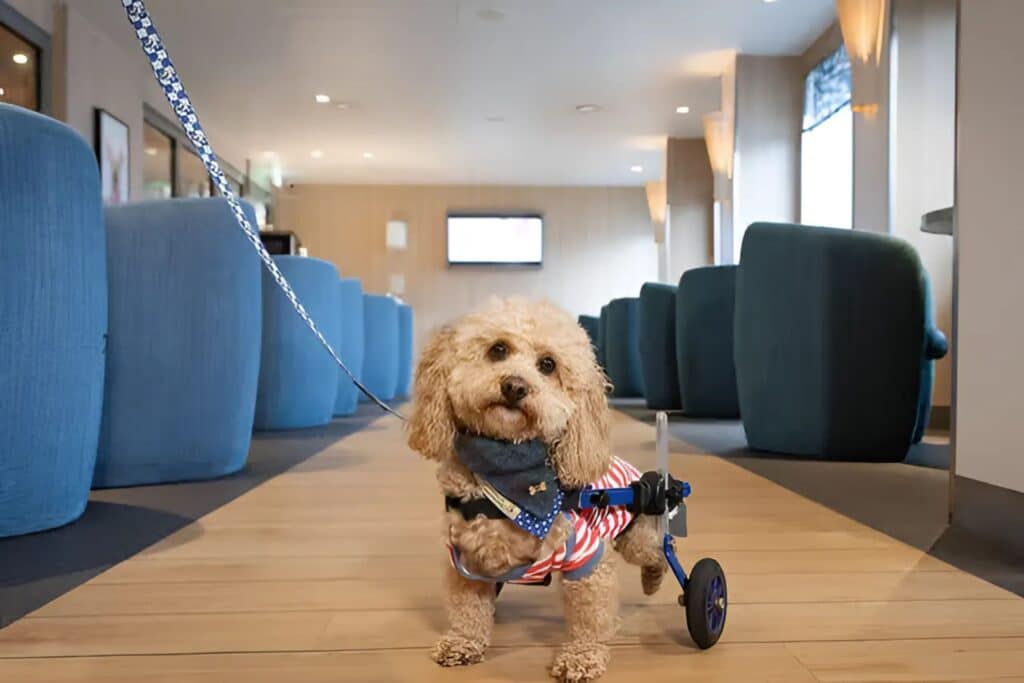
Ref: Henry Wee Wheels visiting Stena Line’s Pet Lounge
Dublin – Holyhead (Stena Adventurer & Estrid)
The Dublin (Ireland) to Holyhead (Wales) route is one of the main links between Ireland and Great Britain, with two large ferries operating up to two sailings each way per day. Crossing time is around 3 hours 15 minutes on the faster ship (Stena Estrid) and a bit longer (~3.5 hours) on the Stena Adventurer, depending on conditions. This is an EU to UK route, so pet documentation needs are a bit more involved, more on that below. The good news is Stena Line has multiple pet travel options on the Dublin–Holyhead route to suit both car and foot passengers.
Pet-Friendly Cabins
Both the Stena Adventurer and the newer Stena Estrid offer a small number of pet-friendly cabins on the Holyhead route. This means you can book a private cabin and keep your dog with you during the trip. Like the other routes, these cabins have a linoleum/vinyl floor and en suite facilities. Up to 2 pets are allowed per cabin (if you have more, you’d need to use kennels for the extras). If you secure a pet cabin, you can settle your dog in the cabin and relax together.
One important difference between the two ships:
- On the Stena Estrid (the newer ferry), if you have a pet cabin you are allowed to take your dog out to a designated outdoor pet area on deck during the crossing. Estrid has been built with pet amenities in mind, so your dog can get some fresh air.
- On the Stena Adventurer, however, pets must remain in the cabin for the entire sailing;there is no specific pet exercise deck on that older vessel. So, if you book a pet cabin on Adventurer, plan to toilet your pup before boarding because you won’t be able to roam the decks with them.
If you need to step out of your cabin (to grab a coffee or use the restroom), it’s best to take your dog with you to the pet deck (if on Estrid) or leave them for only a very short time. Don’t leave them alone in the cabin for more than a few minutes on Adventurer, a barking dog might disturb other passengers in neighbouring cabins.
On routes with pet-friendly cabins (such as Liverpool–Belfast, Holyhead–Dublin, and Fishguard–Rosslare), if your dog is to be transported in a carrier to the cabin, the carrier must not exceed the same maximum dimensions: 91 cm x 62 cm x 56 cm. If your dog is too large for the carrier, you have the option to book a kennel (available on several routes), or your dog can remain in your vehicle for the crossing.
Onboard Kennels
For those who don’t have a pet cabin, Stena Line provides on-board kennels on the Dublin–Holyhead route, particularly on Stena Estrid. The kennels on Estrid are modern and accessible throughout the trip. They even have a door code access so pet owners can visit their animals any time and an adjacent exercise area on deck for dogs to stretch and do their business. This “dog lodge” setup on Estrid is quite appreciated by dog owners, you can pop in to check on your pup, and the ship’s outside deck space for dogs means your pet doesn’t have to be cooped up the whole crossing. The kennels are usually in two sizes (for small and large dogs) and are free to use, but you must reserve a kennel in advance when you book your ticket.
Stena Adventurer also has kennels, though they might be in a less accessible location (potentially on the car deck). If so, on Adventurer the crew might only allow visits to the kennel at set times or not at all during the short trip (If you specifically want to interact with your dog during the crossing, try to book on Stena Estrid where possible, as its facilities are more pet-friendly).
Whether on Estrid or Adventurer, the kennels are free of charge on this route, there’s no extra fee beyond your pet’s passage. Foot passengers with pets will almost always use the kennel option if they don’t have a pet cabin, since it’s not possible to keep a pet with you in the passenger lounges.
In-Car Option
Yes, you are allowed to leave your dog in your vehicle on the Dublin–Holyhead crossings if you wish. Many people travelling by car do choose this option for a 3-hour trip, especially if their dog is accustomed to car travel. There is no charge for having a pet stay in the car, but you still need to declare the pet when booking. If you go this route, take precautions: exercise your dog well before boarding (both Dublin Port and Holyhead port have areas outside terminal buildings where you can walk your dog on leash before check-in), and don’t feed them a big meal right before sailing to avoid nausea. Set up a comfortable spot in the car with ventilation, perhaps use a sunshade on the windshield if it’s a hot day (though the car decks are not in direct sun, they can warm up). Leave a bowl of water and maybe a pad if you’re worried about accidents.
Note: During the crossing, you will not have access to your car, unlike Estrid’s accessible kennels, the car deck is off-limits when the ship is at sea. So you won’t see your pet until arrival. Most dogs nap through it, but if you have any concerns about your dog being anxious alone, a kennel or cabin might be better. Also consider the weather: on rough sea days, a car can slide or vibrate, so secure any loose items around your pet.
Foot Passengers with Dogs
If you’re travelling without a vehicle, you must book either a pet cabin or a kennel for your dog on the Holyhead route. Foot passengers cannot keep pets with them in general seating. On booking, indicate you’re traveling with a pet. At the port, you’ll likely check in at the passenger terminal, and then a shuttle or staff member will guide you and your crated/leashed dog onto the ferry. Holyhead’s terminal has implemented policies in the past where foot passengers with dogs might not be accepted unless pre-arranged, but Stena now explicitly allows it with the kennel/cabin system, just don’t expect to have your dog by your side in the lounge. You’ll head straight to the kennel room to secure your dog. It’s wise to bring a solid carrier or at least have a muzzle on hand if your dog is nervous in crowds, since boarding involves being around other people and possibly pets.
Check-In and Boarding (Dublin–Holyhead)
Arrive a bit early for pet check-in, as document verification can take time. Documentation is crucial on this route because you’re crossing an international border (Ireland is in the EU, Britain is not). If you are departing from Holyhead (UK) to Dublin (EU), you need to make sure your dog meets EU Pet Travel Scheme requirements. This means your dog must be microchipped and vaccinated against rabies, and you need to have either a valid EU Pet Passport or an Animal Health Certificate (AHC) issued by a vet no more than 10 days before travel, showing the rabies shot (and tapeworm treatment if required). Since Britain is no longer in the EU, most people will need an AHC from a UK vet for each trip to Ireland unless your dog has an EU pet passport from a previous trip or from Northern Ireland (NI pet passports are still EU-compatible).
Also, dogs traveling from Great Britain to Ireland must have a tapeworm treatment administered by a vet 1–5 days before entering Ireland, and this must be recorded in the passport or certificate. So, at Holyhead check-in, be prepared to show your dog’s paperwork, Stena Line staff or Irish authorities may ask to see the pet passport/AHC and check that the rabies vaccination is up to date and the tapeworm treatment is recorded for dogs. It might sound strict, but these are the Irish government rules to prevent diseases.
If you are going the other way (Dublin to Holyhead), the UK currently allows EU pet passports and doesn’t require any additional documents for pets coming from the EU. In practice, there are typically no checks on arrival in Holyhead for pets, but you should still have a pet passport or veterinary certificate proving microchip and rabies vaccination, in case it’s asked for. (Brexit note: UK accepts EU passports issued in EU or NI, as well as UK-issued Great Britain pet health certificates for entry, just rarely spot-checks at ferry ports.)
Essentially, ensure you have proof of microchip and vaccinations handy, whichever direction you’re traveling. At check-in, after handling documents, vehicle drivers will be given instructions on where to park on the ship. If you have a pet cabin booked, you’ll get your cabin key at the check-in or onboard. Once you drive aboard, crew will often direct pet owners to park near an elevator or kennel access door. Secure your car and take your dog on lead up to the pet cabin or kennel. Foot passengers will usually board via a shuttle bus or walkway; you might have to carry your smaller pet in a carrier or walk them on leash up the vehicle ramp with a staff escort. The procedure can vary, but port staff are helpful, just ask if unsure where to go with your dog.
Rosslare – Fishguard (Stena Nordica)
The Rosslare (Republic of Ireland) to Fishguard (Wales) service is a shorter Irish Sea crossing of about 3 hours 30 minutes (once daily in each direction). The ship Stena Nordica now operates this route, having replaced the older Stena Europe. Pet travel arrangements on the Rosslare–Fishguard route have improved recently, Stena Nordica was upgraded to include pet-friendly cabins as well as kennels, giving travellers flexibility.
Pet-Friendly Cabins: If you want to stay with your dog during the voyage, you can book one of Stena Nordica’s pet-friendly cabins. These cabins are similar to those on other routes: en suite, with flooring suitable for pets, and allow up to 2 pets inside. There aren’t many of them (likely only a couple per sailing), so definitely reserve early. Having a cabin can make the roughly 3.5-hour trip more relaxed for nervous dogs, you can draw the curtains, play some soft music or TV to drown out unfamiliar noises, and let your dog chill on their bed or next to you. Do bring your own dog bed/blanket and water bowl. The crew will supply some basics like a disposable pet pad and possibly a water bottle, but it’s best to have your own gear for your pet’s comfort.
Note: On Stena Nordica, if you have a pet cabin your pet is expected to remain in the cabin throughout the crossing. Unlike larger ships, Nordica doesn’t have an outside pet exercise deck for cabin users. So plan to take your dog for a good walk before boarding, and perhaps again after disembarkation in Fishguard or Rosslare where there are grassy areas. You’re free to pop out of your cabin to grab a snack from the café, but keep it short, as always, avoid leaving your dog alone for long. If you do need to step out, ensure the door is securely closed behind you (as you don’t want any great escape down the corridor at sea).
On routes with pet-friendly cabins (such as Liverpool–Belfast, Holyhead–Dublin, and Fishguard–Rosslare), if your dog is to be transported in a carrier to the cabin, the carrier must not exceed the same maximum dimensions: 91 cm x 62 cm x 56 cm. If your dog is too large for the carrier, you have the option to book a kennel (available on several routes), or your dog can remain in your vehicle for the crossing.
Onboard Kennels
Stena Nordica also provides pet kennels (dog lodges) on board, and these are typically free to use with a reservation. The kennels are likely similar to what Stena Europe had, a room with a number of lockable cages of various sizes. You must request a kennel when booking if you plan to use one. If you’re a foot passenger with a dog, this is the standard option (unless you book the pet cabin). The kennels allow owners to settle their pets in a secure area.
In-Car Option
Like the Dublin route, leaving your dog in the car is permitted on Rosslare–Fishguard. Many drivers do this for the relatively short hop across the water. There is no extra fee for this option. Standard advice applies: exercise your dog pre-sailing, make sure they’ll be neither too hot nor too cold in the vehicle (the Irish Sea can be chilly, but the car deck is enclosed still, in summer it can warm up). Provide water and maybe a chewy to keep them occupied. Since the journey is only a few hours, most dogs will be fine napping in the car. You will reunite with them when you return to your vehicle upon docking. If you have multiple pets or a large breed that doesn’t fit well in the onboard kennels, the car might actually be the roomier, more comfortable choice, just weigh that against not being able to check on them while at sea.
Foot Passengers with Dogs
Foot travelers on Rosslare–Fishguard must either book a pet cabin or reserve a kennel for the crossing; you can’t have your dog at your seat. The process is similar: at Rosslare or Fishguard port, you’ll check in and likely be asked to wait with your pet (on leash or in carrier) until boarding. You might board via a shuttle or with vehicles. The crew will show you to the kennel room or your cabin. Make sure you have a leash, a muzzle (if your dog requires it), and a pet carrier if your dog is small enough, carriers are handy for keeping cats or small dogs secure during the boarding/disembarking hustle.
Check-In and Boarding (Rosslare–Fishguard)
As with Dublin–Holyhead, this is a UK ⇆ Ireland route, so documentation is key. If you are traveling from Fishguard (Wales, GB) to Rosslare (Ireland), you must follow the EU pet entry rules. That means before leaving Britain, get your dog microchipped (if not already) and vaccinated for rabies, and obtain an EU Pet Passport or an Animal Health Certificate from your vet. Don’t forget the tapeworm treatment for dogs 1-5 days before arrival in Ireland, this is often overlooked, but Irish authorities do check the passport for a vet’s signature on tapeworm treatment when you arrive. If any of these requirements are not met, your pet could be denied entry or quarantined, so it’s worth double-checking everything. The ferry company might ask you to sign a declaration at check-in that you have the necessary papers. When you arrive in Rosslare, an official might do random spot checks (Rosslare Europort does have agricultural inspectors).
If you’re traveling from Rosslare to Fishguard (Ireland to UK), ensure you have at least an EU pet passport or paperwork, while the UK is more lenient, you are supposed to have proof of microchip and rabies vaccination. UK authorities at ferry ports rarely stop pet owners, but it doesn’t mean one shouldn’t comply with the rules. Usually, you’ll just drive off in Fishguard with no stops, or walk through with your pet, but be prepared just in case. During check-in on either side, you’ll get instructions similar to the other routes: drivers with pets might be loaded in a particular order (sometimes pet cars are loaded last so they’re near the doors, making it quicker to get back to your dog on arrival, but this can vary).
Tips for a Smooth Ferry Trip with Your Dog
- Comfort Essentials; Bring your dog’s bed or a familiar blanket, plus their favourite toy or anything with your scent. It’ll help them settle faster in a kennel or cabin. Stena doesn’t provide pet bedding, so pack your own.
- Doggie Bag Must-Haves; Carry a travel kit with a collapsible water bowl, bottled water, food, treats, and poop bags. Include your pet’s documents in an easy-to-reach folder, you may be asked for them more than once.
- Feeding & Medication; Give your dog a light meal a few hours before travel to avoid motion sickness. Bring any medication they need, and if your dog gets anxious, speak to your vet about calming aids or travel sickness tablets. Start any new remedy a few days ahead to see how they react.
- During the Crossing; If you’re in a pet cabin, stay with your dog and keep them calm with a soothing voice or familiar item. In kennels, visit when permitted and offer water or a short walk on deck if allowed. Use the Pet Lounge’s deck area when possible.
- Weather Awareness; Deck areas can be chilly or hot depending on the season. Pack a dog coat for colder crossings and bring water for warmer days. If your dog stays in the car, crack a window and park in the shade if you can.
- Safety & Etiquette; Keep your dog on a short, non-retractable lead at all times and avoid letting them approach others without permission. A harness offers better control, and a muzzle might be required for some breeds or in certain ports, best to bring one just in case. Label your dog’s collar and carrier with your contact details in case of separation.
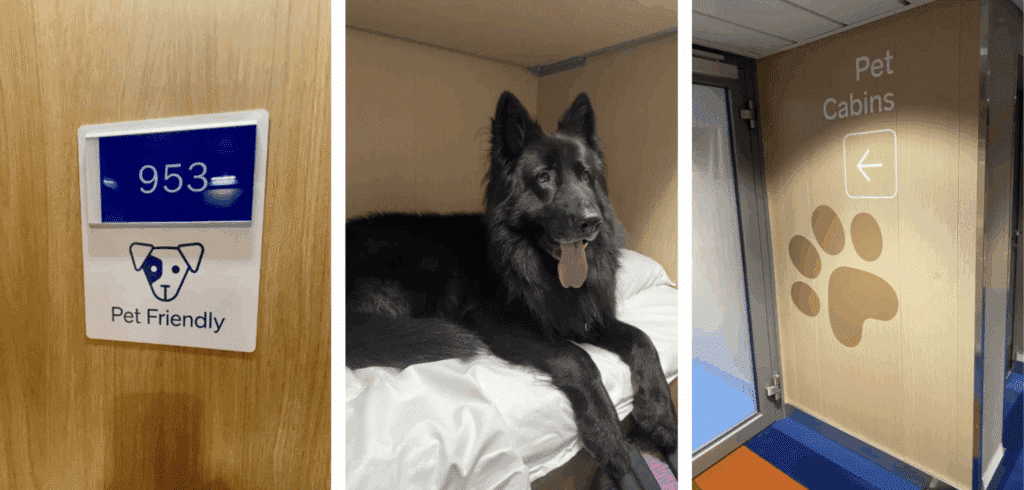
Ref: Things Helen Loves
Post-Travel Plan
Upon arrival, give your dog a chance to relieve themselves as soon as you’re off the ferry. Ports like Fishguard, Holyhead, and Belfast have grassy verges once you’re through the exit gates,a quick stop there can prevent any “welcome home” accidents in your car. Offer water and a small snack once on land to re-establish normal routine. And keep an eye on your pet for any signs of stress or illness after travel, most will bounce back immediately, ready for the next adventure on your holiday itinerary.
By following these tips and being prepared, you’ll set the stage for a calm and enjoyable ferry journey for both you and your dog. Many pet owners report that after the first trip, their dogs get used to the routine and even seem to look forward to the ferry (probably because it often means a fun holiday on the other side!). Stena Line has made a big effort to welcome pets from adding 70 new pet cabins across their Irish Sea fleet to introducing the Pet Lounge, so take advantage of these pet-friendly perks.
With a bit of planning, your furry friend will sail in comfort and style, and you won’t have to leave any family member behind on your next trip across the Irish Sea. Bon voyage and happy tails on the trails of your UK-Ireland adventures.
It’s important to note that the Pet Lounges are currently only suitable for small to medium-sized dogs due to carrier size restrictions. If your dog is larger, it’s best to contact Stena Line directly to confirm whether they can be accommodated and what your alternatives are for the journey.
On routes with pet-friendly cabins (such as Liverpool–Belfast, Holyhead–Dublin, and Fishguard–Rosslare), if your dog is to be transported in a carrier to the cabin, the carrier must not exceed the same maximum dimensions: 91 cm x 62 cm x 56 cm. If your dog is too large for the carrier, you have the option to book a kennel (available on several routes), or your dog can remain in your vehicle for the crossing.
Please note: Stena Line’s pet travel policies, facilities, and weight restrictions may change from time to time. For the most up-to-date information, we recommend checking their official pet travel page.



